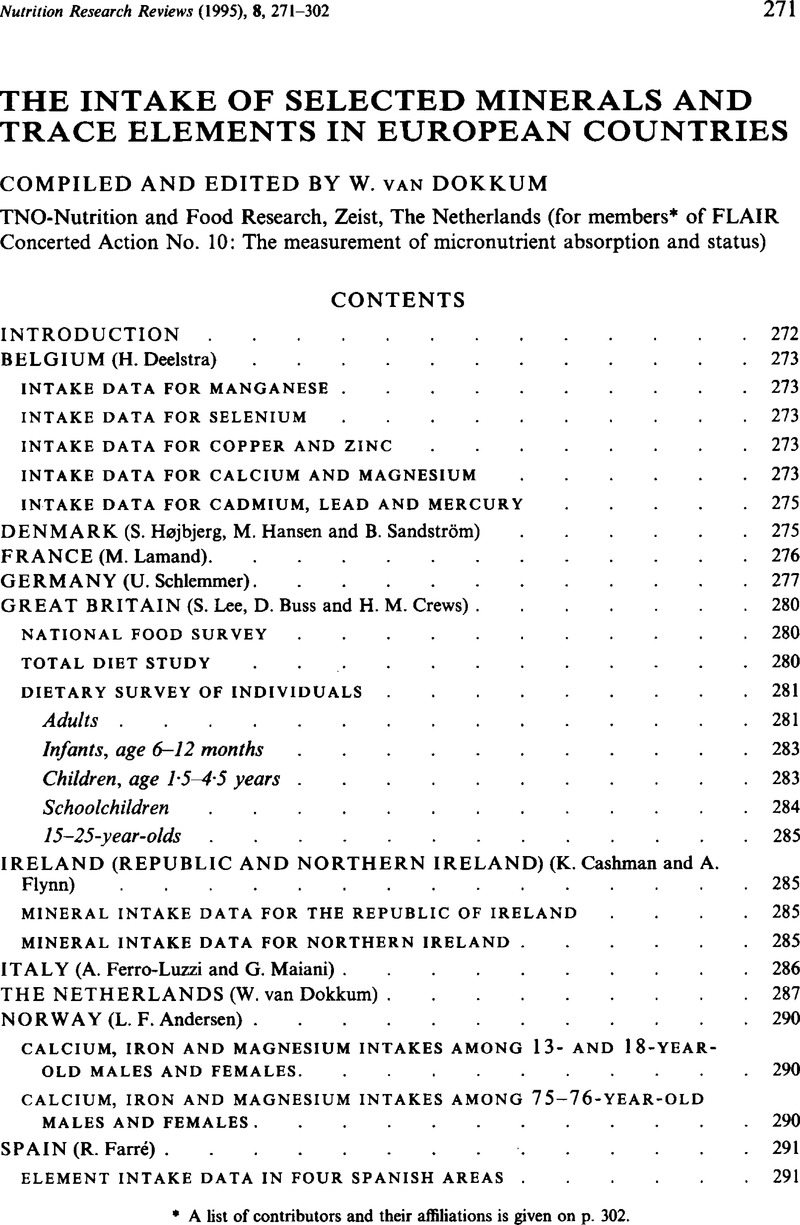Crossref Citations
This article has been cited by the following publications. This list is generated based on data provided by Crossref.
Reilly, Professor Conor
1996.
Selenium supplementation — the Finnish experiment.
Nutrition Bulletin,
Vol. 21,
Issue. 3,
p.
167.
Ginty, Fiona
Flynn, Albert
and
Cashman, Kevin D.
1998.
The effect of short-term calcium supplementation on biochemical markers of bone metabolism in healthy young adults.
British Journal of Nutrition,
Vol. 80,
Issue. 5,
p.
437.
T. Rannem, K. Ladefoged, E. Hylande
1998.
Selenium Depletion in Patients with Gastrointestinal Diseases: Are There Any Predictive Factors?.
Scandinavian Journal of Gastroenterology,
Vol. 33,
Issue. 10,
p.
1057.
Vidal-Quintanar, Reyna Luz
Mendívil, Reyna Luz
Peña, Mireya
and
Fernandez, Maria Luz
1999.
Lime-treated maize husks lower plasma LDL-cholesterol levels in normal and hypercholesterolaemic adult men from northern Mexico.
British Journal of Nutrition,
Vol. 81,
Issue. 4,
p.
281.
Baker, Aimi
Turley, Eithne
Bonham, Maxine P.
O'Connor, Jacqueline M.
Strain, J. J.
Flynn, Albert
and
Cashman, Kevin D.
1999.
No effect of copper supplementation on biochemical markers of bone metabolism in healthy adults.
British Journal of Nutrition,
Vol. 82,
Issue. 4,
p.
283.
Creedon, Annette
Flynn, Albert
and
Cashman, Kevin
1999.
The effect of moderately and severely restricted dietary magnesium intakes on bone composition and bone metabolism in the rat.
British Journal of Nutrition,
Vol. 82,
Issue. 1,
p.
63.
Failla, Mark L.
1999.
Considerations for determining ‘optimal nutrition’ for copper, zinc, manganese and molybdenum.
Proceedings of the Nutrition Society,
Vol. 58,
Issue. 2,
p.
497.
Cashman, KD
Baker, A
Ginty, F
Flynn, A
Strain, JJ
Bonham, MP
O'Connor, JM
Bügel, S
and
Sandström, B
2001.
No effect of copper supplementation on biochemical markers of bone metabolism in healthy young adult females despite apparently improved copper status.
European Journal of Clinical Nutrition,
Vol. 55,
Issue. 7,
p.
525.
Murphy, J
and
Cashman, K.D
2001.
Selenium content of a range of Irish foods.
Food Chemistry,
Vol. 74,
Issue. 4,
p.
493.
Dael, Peter Van
Davidsson, Lena
Muñoz-Box, Rafael
Fay, Laurent B.
and
Barclay, Denis
2001.
Selenium absorption and retention from a selenite- or selenate-fortified milk-based formula in men measured by a stable-isotope technique.
British Journal of Nutrition,
Vol. 85,
Issue. 2,
p.
157.
2002.
Metal Contamination of Food.
p.
137.
Reilly, C.
2002.
The Nutrition Handbook for Food Processors.
p.
97.
Cragg, Ruth A.
Christie, Graham R.
Phillips, Siôn R.
Russi, Rachel M.
Küry, Sébastien
Mathers, John C.
Taylor, Peter M.
and
Ford, Dianne
2002.
A Novel Zinc-regulated Human Zinc Transporter, hZTL1, Is Localized to the Enterocyte Apical Membrane.
Journal of Biological Chemistry,
Vol. 277,
Issue. 25,
p.
22789.
2002.
Metal Contamination of Food.
p.
179.
Cashman, K.D.
2002.
Encyclopedia of Dairy Sciences.
p.
2058.
Cashman, K.D.
2002.
Encyclopedia of Dairy Sciences.
p.
2051.
Cashman, K. D.
2002.
Calcium intake, calcium bioavailability and bone health.
British Journal of Nutrition,
Vol. 87,
Issue. S2,
p.
S169.
Murphy, J
Hannon, EM
Kiely, M
Flynn, A
and
Cashman, KD
2002.
Selenium intakes in 18–64-y-old Irish adults.
European Journal of Clinical Nutrition,
Vol. 56,
Issue. 5,
p.
402.
Biigel, Susanne
2003.
Can human micronutrient status be improved by supplementing domestic animals?.
Proceedings of the Nutrition Society,
Vol. 62,
Issue. 2,
p.
399.
2004.
The Nutritional Trace Metals.
p.
35.





